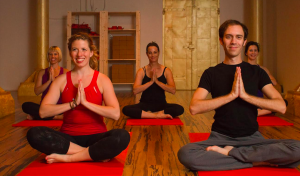I used to teach at a yoga studio that advertised their classes as being heated to “90-95 degrees,” but where in reality the unspoken protocol was to have the room be at least 100, if not 101-102 degrees, with more than 50 percent humidity. I’ve honestly had a love/hate relationship with super hot yoga during the many years I’ve practiced. My first yoga experience ever was at Baptiste, where they do tend to crank the heat, and I’ll admit I was sucked right in by the cleansing, euphoric feeling of leaving the studio all sweaty and rinsed out. I practiced in the heat for about two years before beginning a teacher training program and taught 100 percent of my classes in a 95-plus degree room for the first three years of my teaching career.
Sometimes I loved the heat. It provided an awesome level of intensity to the room, the students largely embraced it, and there was no better place to be during a harsh New England winter than a hot yoga studio. And sometimes I couldn’t stand the heat (or the humidity). I’d find myself gasping for air while trying to spit out a sentence about ujjayi breath, trying my best not to sound winded or exhausted. I’d teach back to back classes and leave with a headache, needing not just a shower, but two bottles of coconut water and a nap.
And then there was the feedback I received at least two years into my teaching, which suddenly became a big deal on the studio owner’s end: “Michael’s classes aren’t hot enough.” “Why do I sweat so much in X teacher’s class but not Michael’s…?” My reply to the owner upon receiving this feedback was that many students approach me after class and tell me that they love the fact that I keep the heat a few degrees cooler in my classes, just like they enjoy the pacing or sequencing of my classes. When I told my boss that I make sure the thermostat gets to about 95 degrees, she replied that she advertises that particular temperature range so as not to scare people away, but that in reality, we are supposed to keep our heat slightly above 100. Heating the room to that extreme level felt really out of integrity with how I wanted to teach my class, so it wasn’t long before I moved on to other studios.
During the time I was receiving this feedback, I started practicing at a studio where the norm was 85 degree classes, and it felt (literally) like such a breath of fresh air. I could regulate my breathing in postures and transitions with more ease, I could do more challenging poses and sustain them longer, and I left class feeling refreshed rather than worn out. That initial feeling of being all rinsed out and dripping with sweat that I felt years ago after my first hot power class kind of got old after a while.

I still teach roughly half of my classes in the heat (and “hot” for me means 90-95 degrees with 40 percent humidity max). And I’m okay with it. Teaching back to back classes in a hot room still does tend to drain me, but that really doesn’t happen in my schedule anymore. I’m mindful of how I sequence and pace my heated classes; I don’t emphasize arm balancing as much, I tend to offer and highlight more options and restful poses, and I give more reminders about the importance of ujjayi breathing and modifying your practice. I’ve never once received any negative feedback about how I heat my classes since that incident years ago, and I think if a student really does have a major hang up about needing to feel that hot and become that drenched with sweat, they’ll seek out a teacher or a studio who pumps the heat up to their liking.
One of the many lessons I’ve learned as a yoga teacher is that you truly can’t please everybody and that trying to do so as a teacher is a dangerous, slippery slope. I’ve catered to student requests before, I always welcome student feedback, and I love building connections and the sense of community. But if something is not in line with my intention for the kind of class that I feel comfortable teaching, I won’t do it just to please someone. I don’t teach “more abs,” set the heat higher, or flow faster just because I know that’s what Nancy in the front row wants. I teach what I feel is a good fit for the majority of the students who show up to the class in a way that is as playful, purposeful, and mindful as I can make it, and the level of heat in the room is to a certain degree, irrelevant. If a student really doesn’t prefer the way I teach or the way I heat my class, I’m not going to lose sleep over it, and it’s great that there are plenty of other teachers out there who will be a better match.
There certainly are some benefits to heating the room for a yoga practice: it warms your muscles, it can help you go a little deeper into the pose (hopefully not too deep), and often times it just plain feels good to sweat and to soak up a little heat. I find myself seeking out warmer classes in the winter for that reason. I think there are also some potential drawbacks and dangers from practicing in a room that’s well over 95 degrees, one of them being that an asana practice is meant to be “comfortable and steady,” according to Patanjali. And at least for this yogi, when I am practicing sun salutation B’s in a 100 degree room, it feels anything but comfortable and steady.
There are so many factors to consider and be mindful of when teaching a class that feels comfortable and steady for the diverse population of students who show up: the sequencing, alignment, pacing, cueing, assisting, injuries, etc. So as yoga teachers, we definitely do have to think mindfully and creatively and become problem solvers. And listen, with the number of classes I teach weekly, I’m dealing with 99 problems, but frankly, the heat ain’t one.
 Michael Mann recently transitioned away from a full-time career teaching vinyasa yoga to begin graduate studies in Journalism. His teaching schedule has dropped to part-time status, and his personal practice has simplified quite a bit in recent years. These days he’s less about that chaturanga, and more about being gentle, mindful, and authentic in the larger practice of everyday life (but not without a healthy dose of sarcasm and irreverence). While he certainly enjoys a good green smoothie, he has not and will not be persuaded by those preachy vegans on his social media feeds to abandon his love for bacon, red wine, and gummy candies. www.michaelmann.com
Michael Mann recently transitioned away from a full-time career teaching vinyasa yoga to begin graduate studies in Journalism. His teaching schedule has dropped to part-time status, and his personal practice has simplified quite a bit in recent years. These days he’s less about that chaturanga, and more about being gentle, mindful, and authentic in the larger practice of everyday life (but not without a healthy dose of sarcasm and irreverence). While he certainly enjoys a good green smoothie, he has not and will not be persuaded by those preachy vegans on his social media feeds to abandon his love for bacon, red wine, and gummy candies. www.michaelmann.com